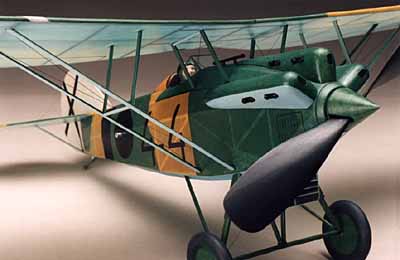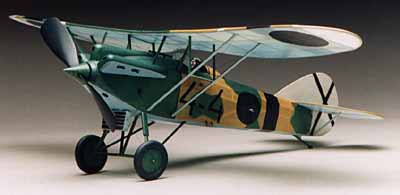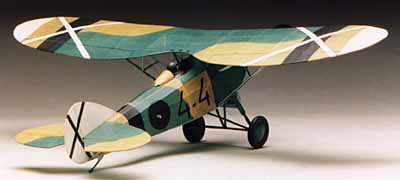Treasures from Chris Parent
PWS-10
| Despite the claim that he stole it all from others, the truth remains that Chris has learned his craft well. This exceptional model shows that clearly, and provides inspiration for all to keep practicing. Notice carefully his landing gear installation. Such flexibility should save many repairs. |
| -Thayer |

| This plane shows what free theft of ideas and techniques from FFML'ers can get you. The 3-view and draft plans came from Nate, the bleached tissue technique came from Jason, the wing structure is George Bredehoft's, the wheels and spinner are balsa using the Colonel (Tom) Sanders rotisserie method (Dremel), some of the markings are from sanded down bond paper (I forget who posted that), and the rest is probably lifted from sources I can't remember. |
|---|
|
All right, it's a PWS-10. A 1930 Polish aircraft done up in Spanish civil war colors.
The basic specs are 1/20th scale, 22" wingspan, 31 gm. balanced, empty weight. (Not bad considering all the stuff hanging on it: radiator, big landing gear, cowl bumps, etc. All balsa.) |

|
|---|
|
The pilot is vacuum formed white styrene from Small Scale. Someday I'll learn to carve pilots from blue foam. The wing is made of 1/16 square ribs formed over a full depth spar. This technique saved me from figuring out how to shape each rib on this oddly shaped wing. The wing and tail outlines are all laminated except for the straight sections on the wing leading edge. |

|
|---|
|
The fuselage has formers above the upper longerons. Just a bunch of sticks below.
The cowl bumps (a real pain to fit to the fuse) and headrest are from very soft hollow balsa. Most rigging is from lycra thread. The rigging between the front and rear cabanes is tight nylon thread since I needed working rigging to keep the wing from wiggling all over the place. The cammoflage is made by bleaching areas of green Japanese tissue (Clorox 1:3 with water) to a very pale yellow. I then used green chalk behind the green areas, and lt. brown chalk behind the pale yellow areas. The fin/rudder and wingtips are chalk white. Black markings are cut tissue. The white X'es on the wing are from bond paper sanded to 50 or 60% thickness.
|

|
The bottom is all white tissue colored with lt. blue chalk (Nupastel #235). Watch out, purple UHU turns the lt. blue chalk to white. White UHU works fine.
The landing gear is extremely flexible via a combination of 1/32 music wire, elastic thread in the axle, bits of tan 2 at the ends of the auxiliary struts, and rear struts that poke into the fuselage. The radiator is also flex-mounted on Tan 2 with elastic thread for the braces. The prop shown is a 20 cm. Union cut down to ~18.5 cm. I have since changed to a 20 cm Peck's prop with the blades narrowed by a lot. This works much better than the original prop. My guess is that it gets the swirling air out away from the cowl bumps, radiator, and other stuff hanging all over this plane. |
|
Very short flight tests look extremely good. It flies stable and slow. I put in a little sneaky curved dihedral to keep the plane steady enough for indoor flying.
I have since reduced the dihedral curve by about 50%. This and a slightly larger vertical tail cured some early dutch roll problems. I tried flying it indoors this winter, but our sites here are too small for such a breakable plane. It now flies really well outdoors. |
Copyright 1999, Thayer Syme. All rights reserved